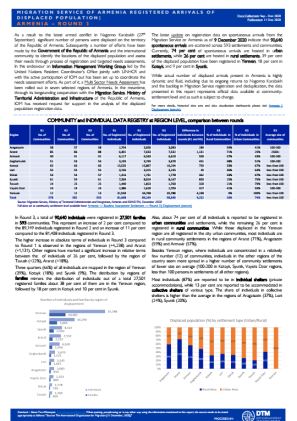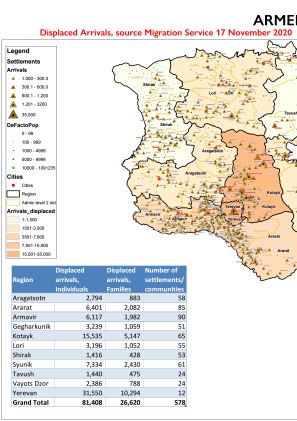-
Countries
-
Data and Analysis
-
Special Focus
-
Crisis Responses
Armenia
IDPs tracked
Displacement Movements
8,400
IDMC 2022
Data collection round
About Armenia
Processing
Round 1 data from Migration Service, Government of Armenia was received on 17 November 2020 and Round 2 data on 30 November as export from registration database as aggregates on settlement level with population values by settlement name in Armenian language in 11 regional worksheets.
Round 3 data was received on 9 December 2020 as export of anonymized individual records from registration database with information on age, sex, shelter, region of origin in NK and current settlement location in ARM.
Processed by DTM team (on 9 and 10 December 2020) of IOM in Mobility Tracking, baseline database where population values were summarized for all 593 settlement after location and name verification.
Aggregated number for tabulation by settlement and region were generated from DTM database.
First release of data is published on DTM website on 11 December 2020
Detailed settlement dataset with geographic coordinates and settlement codes (from Armenia statistical office) connected to MS database settlement codes was generated.
Geographic reference Armenia
Admin 1, source HDX: https://data.humdata.org/dataset/armenia-administrative-boundaries
Settlement, source https://ace.aua.am/vector-database-armenia-file-overview/
Map links
Contact
Ilona Terminasyan,
iterminasyan@iom.int
Armenia — Displacement Report — December 2020— Round 3
As a result to the latest armed conflict in Nagorno Karabakh (27th September) significant number of persons were displaced on the territory of the Republic of Armenia.
Armenia — Displacement Report — December 2020 - Round 2
On the morning of 27 September, renewed hostilities erupted in and around the Nagorno-Karabakh conflict zone. This was the latest flare up in a conflict that has been ongoing for over thirty years.
Armenia — Arrivals of Displaced Individuals Overview Map — Novermber 2020
On the morning of 27 September, renewed hostilities erupted in and around the Nagorno-Karabakh conflict zone.
Armenia — Baseline Assessment Settlement — Round 3
2020-12-10
A baseline assessment is a sub-component of mobility tracking. It aims to collect data on IDP, migrant or returnee population presence in a defined administrative area of the country. Round 3 data was received on 9 December 2020 as export of anonymized individual records from registration database…
Armenia — Baseline Assessment Settlement — Round 2
2020-12-01
This dataset contain data collected in Round 2. Processing: Round 1 data from Migration Service, Government of Armenia was received on 17 November 2020 and Round 2 data on 30 November as export from registration database as aggregates on settlement level with population values by settlement name…
Armenia — Baseline Assessment Tabulations — Round 1
2020-11-17
On the morning of 27 September, renewed hostilities erupted in and around the Nagorno-Karabakh conflict zone. This was the latest flare up in a conflict that has been ongoing for over thirty years. On 9 November 2020, the Prime Minister of Armenia, the President of Azerbaijan, and the President of…
Arrivals Of Displaced Individuals In Settlements Overview - Round 3
This map is representing an overview of arrivals of displaced indivials in settlements of Round 3.Round 3 data was received on 9 December 2020 as export of anonymized individual records from registration database with information on age, sex, shelter, region of origin in NK and current settlement location in ARM.Processed by DTM team (on 9 and 10 December 2020) of IOM in Mobility Tracking, baseline database where population values were summarized for all 593 settlement after location and name verification.Aggregated number for tabulation by settlement and region were generated from DTM database.First release of data is published on DTM website on 11 December 2020Detailed settlement dataset with geographic coordinates and settlement codes (from Armenia statistical office) connected to MS database settlement codes was generated. Geographic reference ArmeniaAdmin 1, source HDX: https://data.humdata.org/dataset/armenia-administrative-boundariesSettlement, source https://ace.aua.am/vector-database-armenia-file-overview/
Arrivals of Displaced Individuals In Settlements Overview - Round 2
This map is representing an overview of arrivals of displaced indivials in settlements of Round 2.Round 1 data from Migration Service, Government of Armenia was received on 17 November 2020 and Round 2 data on 30 November as export from registration database as aggregates on settlement level with population values by settlement name in Armenian language in 11 regional worksheets. Data was processed by DTM team of IOM in Mobility Tracking baseline database where population values were entered each and one individually for all settlements after location and name verification. The map representing the arrivals in settlements is available through the following link: https://displacement.iom.int/maps/arrivals-displaced-individuals-settlements Aggregated number for tabulation by region are generated from DTM database. Detailed settlement dataset with geographic coordinates and settlement codes (from Armenia statistical office) was generated. Geographic reference:Armenia Admin 1,source HDX: https://data.humdata.org/dataset/armenia-administrative-boundaries Settlement, source: https://ace.aua.am/vector-database-armenia-file-overview/
Arrivals of displaced individuals in settlements
This map is representing an overview of arrivals of displaced indivials in settlements.On the morning of 27 September, renewed hostilities erupted in and around the Nagorno-Karabakh conflict zone. This was the latest flare up in a conflict that has been ongoing for over thirty years. On 9 November 2020, the Prime Minister of Armenia, the President of Azerbaijan, and the President of Russia announced a tripartite ceasefire agreement ending the hostilities in and around the Nagorno-Karabakh (NK) conflict zone.While data on the population displaced as a result of the conflict and their needs remains limited, a number of first efforts have been rolled out to assess displacement locations and needs. As the first efforts at collecting information on the needs of displaced and host communities are being rolled out in ten selected districts, an Information Management Working Group has been set up to coordinate efforts, led by the United Nations Resident Coordinator’s Office jointly with UNHCR and with the active participation of IOM. In meantime IOM has received the registration data form the Armenian Migration Service on 17 November 2020 as export from registration database as aggregates on settlement level with population values (of individuals and families) by settlement name. The latest registration data on spontaneous arrivals from the Armenian Migration Services from 17 November 2020 indicate that 81,408 spontaneous arrivals are scattered across 578 settlements and communities. 74 per cent of spontaneous arrivals are currently hosted in urban settlements, while 26 per cent are hosted in rural settlements. 39 per cent of the displaced have been registered in Yerevan, 19 per cent in Kotayk, and 9 per cent in Syunik.IOM will provide support with systematizing and presenting data that is already being collected by the UN agencies and other actors, drawing on its Displacement Tracking Matrix (DTM) tools and has deployed an expert to support this process.








